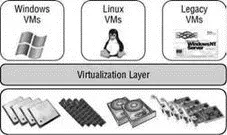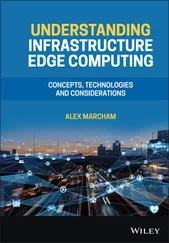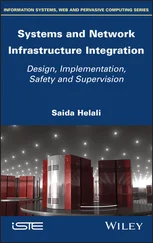Chris McCain - Mastering VMware® Infrastructure3
Здесь есть возможность читать онлайн «Chris McCain - Mastering VMware® Infrastructure3» — ознакомительный отрывок электронной книги совершенно бесплатно, а после прочтения отрывка купить полную версию. В некоторых случаях можно слушать аудио, скачать через торрент в формате fb2 и присутствует краткое содержание. Город: Indianapolis, Год выпуска: 2008, ISBN: 2008, Издательство: WILEY Wiley Publishing, Inc., Жанр: Программы, ОС и Сети, на английском языке. Описание произведения, (предисловие) а так же отзывы посетителей доступны на портале библиотеки ЛибКат.
- Название:Mastering VMware® Infrastructure3
- Автор:
- Издательство:WILEY Wiley Publishing, Inc.
- Жанр:
- Год:2008
- Город:Indianapolis
- ISBN:978-0-470-18313-7
- Рейтинг книги:5 / 5. Голосов: 1
-
Избранное:Добавить в избранное
- Отзывы:
-
Ваша оценка:
- 100
- 1
- 2
- 3
- 4
- 5
Mastering VMware® Infrastructure3: краткое содержание, описание и аннотация
Предлагаем к чтению аннотацию, описание, краткое содержание или предисловие (зависит от того, что написал сам автор книги «Mastering VMware® Infrastructure3»). Если вы не нашли необходимую информацию о книге — напишите в комментариях, мы постараемся отыскать её.
Mastering VMware® Infrastructure3 — читать онлайн ознакомительный отрывок
Ниже представлен текст книги, разбитый по страницам. Система сохранения места последней прочитанной страницы, позволяет с удобством читать онлайн бесплатно книгу «Mastering VMware® Infrastructure3», без необходимости каждый раз заново искать на чём Вы остановились. Поставьте закладку, и сможете в любой момент перейти на страницу, на которой закончили чтение.
Интервал:
Закладка:
Virtualization involves the installation of software commonly called a hypervisor. The hypervisor is the virtualization layer that allows multiple operating systems to run on top of the same set of physical hardware. Figure I.1 shows the technological structure of a virtualized computing environment. Virtual machines that run on top of the hypervisor can run almost any operating system, including the most common Windows and Linux operating systems found today as well as legacy operating systems from the past.

Figure I.1The process of virtualization involves a virtualization layer called a hypervisor that separates the physical hardware from the virtual machines. This hypervisor manages the virtual machines' access to the underlying hardware components.
For those just beginning the journey to a virtual server environment and for those who have already established their virtual infrastructures, the reasons for using virtualization can vary. Virtualization offers many significant benefits, including server consolidation, rapid server provisioning, new options in disaster recovery, and better opportunities to maintain service-level agreements (SLAs), to name a few. Perhaps the most common reason is server consolidation.
Most servers in a datacenter are performing at less than 10 percent CPU utilization. This leaves an overwhelming amount of processing power available but not accessible because of the separation of services. By virtualizing servers into virtual machines running on a hypervisor, we can better use our processors while reducing rack space needs and power consumption in the datacenter.
Depending on the product used to virtualize a server environment, there are many more benefits to virtualization. Think of the struggles IT professionals have had throughout the years and you'll gain a terrific insight into why virtualization has become such a popular solution. The simple process of moving a server from a datacenter in Tampa, Florida, to a datacenter in Atlanta, Georgia, is a good example of a common pain point for IT pros. The overhead of removing an 80-pound server from a rack, boxing it, shipping it, unboxing it, and placing it back into another rack is enough to make you want to virtualize. With virtual machines this same relocation process can be reduced to simply copying a directory to an external media device, shipping the external media device, and copying the directory back to another ESX implementation. Other methods, such as virtual machine replication and full and delta images of virtual machines, can be taken with third-party tools.
Although a handful of products have emerged for enterprise-level virtualization, this book provides all of the details an IT professional needs to design, deploy, manage, and monitor an environment built on the leading virtualization product, VMware Infrastructure 3.
This book is written with a start-to-finish approach to installing, configuring, managing, and monitoring a virtual environment using the VMware Infrastructure 3 (VI3) product suite. The book begins by introducing the VI3 product suite and all of its great features. After introducing all of the bells and whistles, this book details an installation of the product and then moves into configuration. Upon completion of the installation and configuration, we move into virtual machine creation and management, and then into monitoring and troubleshooting. This book can be read from cover to cover to gain an understanding of the VI3 product in preparation for a new virtual environment. Or it can also be used as a reference for IT professionals who have begun their virtualization and want to complement their skills with real-world tips, tricks, and best practices as found in each chapter.
This book, geared toward the aspiring and the practicing virtualization professional, provides information to help implement, manage, maintain, and troubleshoot an enterprise virtualization scenario. As an added benefit we have included four appendices: one offering solutions to Master It problems, another detailing common Linux and ESX commands, another discussing some of the more popular tools and third-party products that can be used to facilitate virtual infrastructure management, and another describing best practices for VI3.
Here is a glance at what's in each chapter:
Chapter 1: IntroducingVMware Infrastructure 3 begins with a general overview of all the products that make up the VI3 product suite. VMware has created a suite with components to allow for granular licensing and customization of features for each unique deployment.
Chapter 2: Planning and Installing ESX Serverlooks at planning the physical hardware, calculating the return on investment, and installing ESX Server 3.5 both manually and in an unattended fashion.
Chapter 3: Creating and Managing Virtual Networks dives deep into the design, management, and optimization of virtual networks. In addition, it initiates discussions and provides solutions on how to integrate the virtual networking architecture with the physical network architecture while maintaining network security.
Chapter 4: Creating and Managing Storage Devices provides an in-depth overview of the various storage architectures available for ESX Server 3.5. This chapter discusses fibre channel, iSCSI, and NAS storage design and optimization techniques as well as the new advanced storage features like round-robin load balancing, NPIV, and Storage VMotion.
Chapter 5: Installing and Configuring VirtualCenter 2.0 offers an all-encompassing look at VirtualCenter 2.5 as the brains behind the management and operations of a virtual infrastructure built on the VI3 product suite. From planning, installing, and configuring, this chapter covers all aspects of VirtualCenter 2.5.
Chapter 6: Creating and Managing Virtual Machines introduces the practices and procedures involved in provisioning virtual machines through VirtualCenter 2.5. In addition, you'll be introduced to timesaving techniques, virtual machine optimization, and best practices that will ensure simplified management as the number of virtual machines grows larger over time.
Chapter 7: Migrating and Importing Virtual Machines continues with more information about virtual machines but with an emphasis on performing physical-to-virtual (P2V) and virtual-to-virtual (V2V) migrations in the VI3 environment. This chapter provides a solid, working understanding of the VMware Converter Enterprise tool and offers real-world hints at easing the pains of transitioning physical environments into virtual realities.
Читать дальшеИнтервал:
Закладка:
Похожие книги на «Mastering VMware® Infrastructure3»
Представляем Вашему вниманию похожие книги на «Mastering VMware® Infrastructure3» списком для выбора. Мы отобрали схожую по названию и смыслу литературу в надежде предоставить читателям больше вариантов отыскать новые, интересные, ещё непрочитанные произведения.
Обсуждение, отзывы о книге «Mastering VMware® Infrastructure3» и просто собственные мнения читателей. Оставьте ваши комментарии, напишите, что Вы думаете о произведении, его смысле или главных героях. Укажите что конкретно понравилось, а что нет, и почему Вы так считаете.












